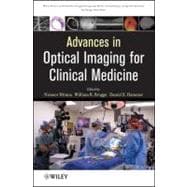
Note: Supplemental materials are not guaranteed with Rental or Used book purchases.
Purchase Benefits
Looking to rent a book? Rent Advances in Optical Imaging for Clinical Medicine [ISBN: 9780470619094] for the semester, quarter, and short term or search our site for other textbooks by Iftimia, Nicusor; Brugge, William R.; Hammer, Daniel X.. Renting a textbook can save you up to 90% from the cost of buying.
| Introduction | |
| Traditional Imaging Modalities in Clinical Medicine | |
| Introduction | |
| Diagnostic imaging technologies | |
| Imaging for radiation therapy planning | |
| Image-guided radiation therapy | |
| Conclusions | |
| Current imaging approaches and further imaging needs in clinical medicine: A clinician perspective | |
| Ophthalmic Imaging | |
| Imaging of the Gastrointestinal Mucosa | |
| Cardioimaging | |
| Neuroimaging: current technologies and further needs | |
| Advances in Retinal Imaging | |
| Introduction | |
| Prevalent Retinal Diseases | |
| Traditional Imaging Technologies | |
| Advanced Imaging Technologies | |
| Imaging Beyond Disease Detection | |
| Conclusion | |
| Confocal Microscopy of Skin Cancer | |
| Introduction | |
| Imaging of Normal Skin In Vivo | |
| Imaging of Cutaneous Neoplasms In Vivo - correlation with dermoscopy and histopathology | |
| Mosaicing of Excised Skin Ex Vivo | |
| Intra-operative Mapping of Surgical Margin | |
| Challenging Cases | |
| Future perspectives | |
| Acknowledgements | |
| High-resolution optical coherence tomography imaging in gastroenterology | |
| Introduction | |
| Optical Coherence Tomography | |
| Clinical Gastrointestinal Imaging | |
| Future Directions | |
| Conclusions | |
| High-resolution confocal endomicroscopy for gastrointestinal cancer detection | |
| Introduction and motivation | |
| Conventional confocal endomicroscopy | |
| Dual-axis confocal endomicroscopy | |
| Toward larger fields of view?mosaicing | |
| Summary and future directions | |
| High-resolution Optical Imaging in Interventional Cardiology | |
| Introduction | |
| Current Invasive Imaging Modalities In interventional Cardiology | |
| High-resolution optical coherence tomography imaging in | |
| Current Limitations of OCT | |
| Future developments | |
| Conclusion | |
| Fluorescence Lifetime Spectroscopy in Cardio and Neuroimaging | |
| Introduction | |
| Fluorescence lifetime spectroscopy in tissue characterization | |
| Time-Resolved Fluorescence Spectroscopy - Instrumentation | |
| Time-Resolved Fluorescence Spectroscopy - Data Analysis Methods | |
| Atherosclerotic plaque | |
| Primary brain tumors | |
| Concluding remarks | |
| Acknowledgments | |
| References | |
| Advanced Optical Methods for Functional Brain Imaging | |
| Introduction | |
| Optical technologies for noninvasive neural activity mapping | |
| Optical imaging of the depth-resolved functional activity in cortex | |
| Novel approaches | |
| Conclusions | |
| Advances in Optical Mammography | |
| Introduction | |
| Structure and Physiology of human female breast: an optical perspective | |
| Optical Imaging breast technology | |
| In-vivo optical properties of healthy breast | |
| Optical imaging in breast oncology | |
| Multimodality Approaches | |
| Summary | |
| Photoacoustic Tomography | |
| Introduction | |
| Photoacoustic Theory | |
| PAT Imaging Methods | |
| Photoacoustic Wave Equations | |
| Finite Element and Model-Based PAT Reconstruction Methods | |
| Quantitative PAT | |
| PAT Imaging Instrumentation | |
| In vivo Applications | |
| References | |
| Optical Imaging and Measurement of Angiogenesis | |
| Introduction | |
| Angiogenesis ? A brief overview | |
| Potential clinical applications | |
| Optical techniques to image angiogenesis | |
| Other modalities | |
| Conclusions | |
| High-resolution Phase Contrast Optical Coherence Tomography for Functional Biomedical Imaging | |
| Introduction | |
| Time Domain Phase Sensitive Interferometry | |
| Spectral Domain Phase Sensitive Interferometry | |
| Applications of differential phase contrast imaging | |
| Comparison of time domain and spectral domain phase-sensitive systems | |
| Conclusion | |
| Polarization imaging | |
| Introduction | |
| Polarization analysis | |
| Polarization microscopy | |
| Biomedical applications | |
| Other polarization imaging applications | |
| Conclusions | |
| Nanotechnology Approaches for Contrast Enhancement in Optical Imaging and Disease Targeted Therapy | |
| Introduction | |
| Nanotechnology-based contrast agents for optical imaging and targeted therapy | |
| Enhanced contrast optical imaging using functionalized nonoprobes | |
| Nanotechnology-based drug delivery systems for disease-targeted therapy and tissue | |
| Conclusions | |
| Molecular probes for optical contrast enhancement of gastrointestinal cancers | |
| Introduction | |
| DNA Microarrays for Target Identification | |
| Phage Display | |
| Potential Targets and Possible Pitfalls | |
| Probe Design | |
| Conclusion | |
| Table of Contents provided by Publisher. All Rights Reserved. |
The New copy of this book will include any supplemental materials advertised. Please check the title of the book to determine if it should include any access cards, study guides, lab manuals, CDs, etc.
The Used, Rental and eBook copies of this book are not guaranteed to include any supplemental materials. Typically, only the book itself is included. This is true even if the title states it includes any access cards, study guides, lab manuals, CDs, etc.